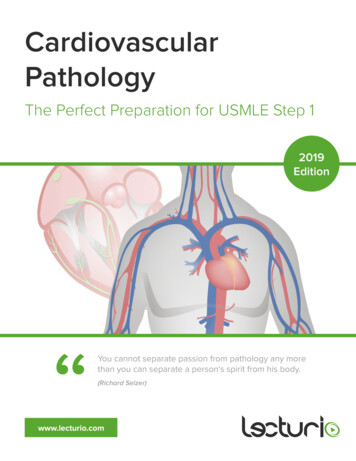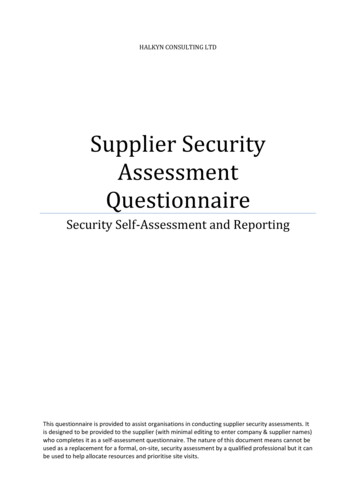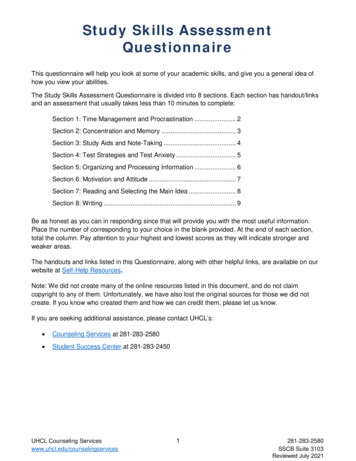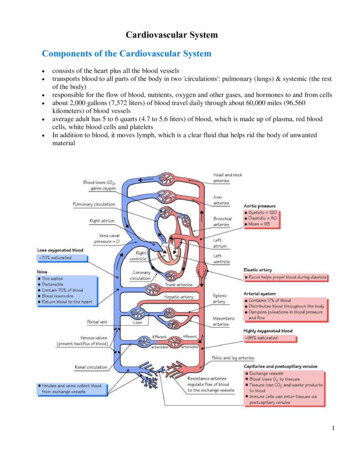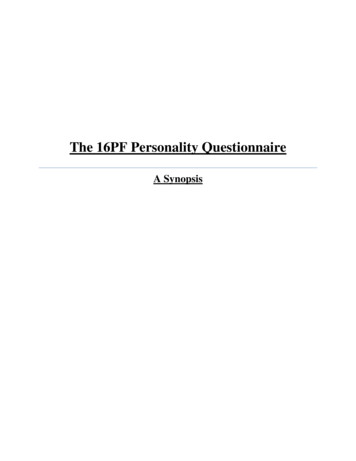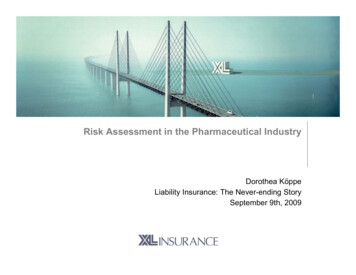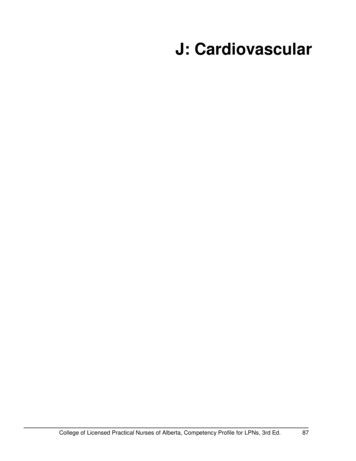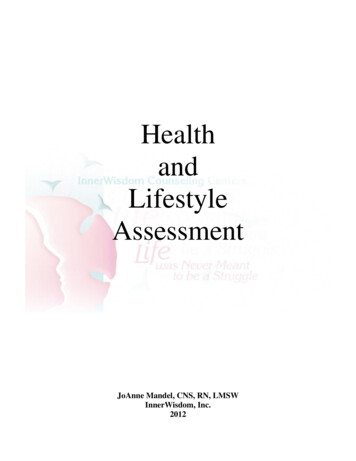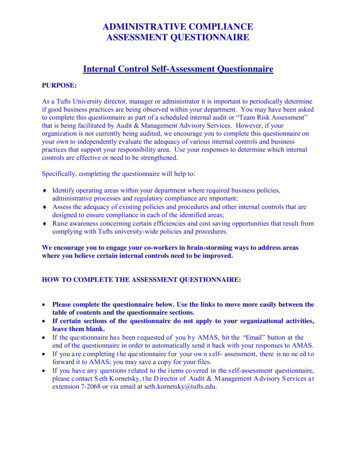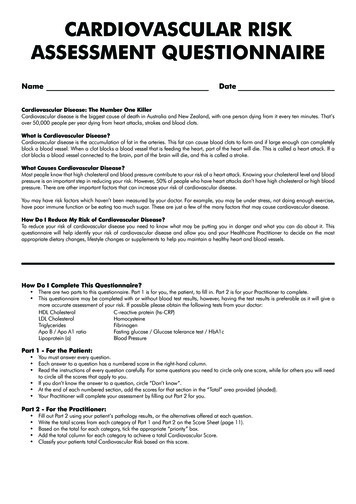
Transcription
CARDIOVASCULAR RISKASSESSMENT QUESTIONNAIRENameDateCardiovascular Disease: The Number One KillerCardiovascular disease is the biggest cause of death in Australia and New Zealand, with one person dying from it every ten minutes. That’sover 50,000 people per year dying from heart attacks, strokes and blood clots.What is Cardiovascular Disease?Cardiovascular disease is the accumulation of fat in the arteries. This fat can cause blood clots to form and if large enough can completelyblock a blood vessel. When a clot blocks a blood vessel that is feeding the heart, part of the heart will die. This is called a heart attack. If aclot blocks a blood vessel connected to the brain, part of the brain will die, and this is called a stroke.What Causes Cardiovascular Disease?Most people know that high cholesterol and blood pressure contribute to your risk of a heart attack. Knowing your cholesterol level and bloodpressure is an important step in reducing your risk. However, 50% of people who have heart attacks don’t have high cholesterol or high bloodpressure. There are other important factors that can increase your risk of cardiovascular disease.You may have risk factors which haven’t been measured by your doctor. For example, you may be under stress, not doing enough exercise,have poor immune function or be eating too much sugar. These are just a few of the many factors that may cause cardiovascular disease.How Do I Reduce My Risk of Cardiovascular Disease?To reduce your risk of cardiovascular disease you need to know what may be putting you in danger and what you can do about it. Thisquestionnaire will help identify your risk of cardiovascular disease and allow you and your Healthcare Practitioner to decide on the mostappropriate dietary changes, lifestyle changes or supplements to help you maintain a healthy heart and blood vessels.How Do I Complete This Questionnaire? There are two parts to this questionnaire. Part 1 is for you, the patient, to fill in. Part 2 is for your Practitioner to complete. This questionnaire may be completed with or without blood test results, however, having the test results is preferable as it will give amore accurate assessment of your risk. If possible please obtain the following tests from your doctor:HDL CholesterolC-reactive protein (hs-CRP)LDL CholesterolHomocysteineTriglyceridesFibrinogenApo B / Apo A1 ratioFasting glucose / Glucose tolerance test / HbA1cLipoprotein (a)Blood PressurePart 1 - For the Patient: You must answer every question. Each answer to a question has a numbered score in the right-hand column. Read the instructions of every question carefully. For some questions you need to circle only one score, while for others you will needto circle all the scores that apply to you. If you don’t know the answer to a question, circle “Don’t know”. At the end of each numbered section, add the scores for that section in the “Total” area provided (shaded). Your Practitioner will complete your assessment by filling out Part 2 for you.Part 2 - For the Practitioner: Fill out Part 2 using your patient’s pathology results, or the alternatives offered at each question.Write the total scores from each category of Part 1 and Part 2 on the Score Sheet (page 11).Based on the total for each category, tick the appropriate “priority” box.Add the total column for each category to achieve a total Cardiovascular Score.Classify your patients total Cardiovascular Risk based on this score.
PART 1: Patient Questionnaire – Patient to complete2AgeLifestyleSection (a) How old are you? (circle one score)Section (a) Exercise (circle one score)Moderate exercise is brisk walking, jogging, cycling, swimming,playing sports or any exercise that increases breathing and heart ratecontinuously for at least 20 minutes.Under 30030 – 34135 – 39640 – 4415Sedentary – moderate exercise less thanonce a week45 – 4940Moderate exercise (average once per week)50 – 5470Moderate exercise (average 2 – 3 times per week)-1055 – 59100Moderate exercise (average 4 – 5 times per week)-2060 – 64110-2565 – 69120Moderate exercise(average 5 or more times per week)70 – 7413075 and over140Add Age Total:Cardiovascular HistorySection (a) (circle score if applicable)Do you have diagnosed cardiovascular disease,atherosclerosis, previous heart attack, and/orprevious stroke100Have you experienced angina (heart pain)within the last 3 months150201Section (b) Smoking (circle one score)Never smoked0Ex-smoker10Current smoker less than 20 cigarettes/day50Current smoker more than 20 cigarettes/day80Section (c) Passive smoking (a non-smoker exposed tosmoke most days at home or work) (circle one score)Yes25No0Section (d) Alcohol (circle score if applicable)Add Cardiovascular History Total:Average 0 drinks daily0-10Family HisoryAverage 1 drink daily or 7 units per weekAverage 2 drinks daily or 14 units per week-5Section (a) (circle score if applicable)Average 3 or more drinks daily or 21 or more unitsper week5Mother with Cardiovascular Disease at less than65 years (high blood pressure, heart attack,angina, stroke, hardening of the arteries)Father with Cardiovascular Disease at less than55 years (high blood pressure, heart attack,angina, stroke, hardening of the arteries)Parent with Type II Diabetes (adult-onset diabetes)Add Family History Total:151515Section (e) Alcohol (circle score if applicable)Do you consume:Male: 5 or more drinksFemale: 3 or more drinksin one sitting on a fortnightly or more frequent basis?7Section (f) Environment (circle score if applicable)Do you live on a main road?4Do you live in a city?3Do you live in an industrial area with gasemissions?2Do you work with any chemicals, cleaners,pesticides, petrochemicals, paints, exhausts?4Add Lifestyle Total (section a to f):
PART 1: Patient Questionnaire – Patient to complete3StressSection (a) Have you experienced any of the followingevents in the past 6 months? (circle score if applicable)Section (b) Do you participate in any of the followingactivities for more than an hour a week? (circle score ifapplicable)Death of spouse30Meditation/prayer-5Death of family member20Yoga/stretching/relaxation exercises-5Divorce/separation20Community events/social activities/sports-5Marital reconciliation20Play with pets-4Jail term20Major illness/injury/surgery20Marriage10Dismissal from work10Retirement10Death of a friend8Illness in the family8Sexual difficulties5Pregnancy5Moving to a new town/city/country5Family/relationship disputes5Change in financial state3Change of occupation3Change in work responsibilities3Mortgage3Major family events – weddings, births in theimmediate family3Son or daughter leaving home3Personal difficulties at work3Outstanding personal achievement2Change in residence2Change in schools2Change in social habits2Change in routine2Holidays2Christmas2Minor violations of the law2Section (c) (circle score if applicable)Do you feel anxiety, worry, fear, sudden feelings ofpanic, inability to control breathing and acceleratedheart rate when upset, or recurrent feelings ofunease?Weekly ormore:40Monthlyor more:20Do you have feelings of sadness, depression,hopelessness, apathy, gloom, helplessness,isolation, loneliness, or lack of interest in socialinteraction?Weekly ormore:30Monthlyor more:15Are you easily angered or frustrated, feel resentment or hostility towards others or frequentlyirritable?Weekly ormore:25Monthlyor more:12Add Stress Total (section a to c):SleepSection (a) How many hours of sleep do you have onaverage per night? (circle one score)0–465–637–80More than 8 hours4Section (b) Do you experience? (circle score if applicable)3SnoringObstructive sleep apnoeaInsomnia, difficulty falling asleep or interruptedsleepAdd Sleep Total (section a to b):103
PART 1: Patient Questionnaire – Patient to complete4Bowel ToxicityInflammation and PainSection (a) Do you regularly experience lower abdominalpain, gas, bloating, diarrhoea, constipation, strainingwhen passing bowel motions, excessively smelly stoolsand/or a feeling that your bowels do not completelyempty? (circle one score)Section (a) Do you experience any of the followingsymptoms more than once a month? (circle score ifapplicable)Yes8No0Section (b) Have you taken the oral contraceptive pill formore than 6 months in the last year? (circle one score)Wheezing, sneezing, a runny nose, sore throat,itchy or watery eyes, coughing and/or blocked nose5Heart palpitations or headaches after certain foods5Section (b) Do you experience recurrent pain? (circle onescore)Daily3015Yes5WeeklyNo0Monthly or less5Never0Section (c) For what length of time have you been onantibiotics in the last year? (circle one score)Less than 2 weeks02 weeks – 2 months22 – 6 months5Longer than 6 months10Add Bowel Toxicity Total (section a to c):Blood SugarSection (a) (circle score if any of these statements areapplicable)Do you feel your energy levels drop within an hourof eating? and /orDo you experience cravings for sweets or chocolate?and /orDo you have headaches or an inability toconcentrate which is relieved by eating?10Section (b) Are you diabetic? (circle score if applicable)Yes100No0Add Blood Sugar Total (section a to b):Add Inflammation and Pain Total(section a to b):
PART 1: Patient Questionnaire – Patient to complete5Diet(a)(b)(c)(d)(e)(f)(g)(h)(i)(j)How often do you usually eat friedfoods?Less than once a week1 – 2 times a week3 – 6 times a weekEvery day015100 – 1 serves daily2 serves daily3 serves daily4 or moreserves daily0024Usually none1 – 2 serves dailyMore than 2 servesdaily028How many teaspoons of sugar doyou consume daily in hot drinks,added to foods, etc.?0–34–67–910 or more0147How often do you usually eat fish?Rarely1 – 2 times a week3 – 6 times a weekEvery day0-2-5-10Usually none1 – 3 pieces daily4 or more pieces daily0-2-3How many serves of vegetables(excluding potatoes) do you usuallyeat a day? (1 serve approximately1 handful)Usually none1 – 2 serves daily3 – 4 serves daily5 or more serves daily0-3-5-10How many cups of coffee do youusually drink a day?Usually none1 – 2 cups daily3 – 4 cups daily5 or more cups daily0024Less than 500 mlper week1 – 2 litres per week3 – 4 litres per week5 or more litresper week02480 – 500 ml501 ml – 1.25 litresMore than 1.25 litres730How many serves of bread, pasta,rice, potatoes or other starchy foodsdo you have a day?How many servings of sweet foodslike cakes, biscuits, lollies and/orchocolate do you consume a day?How many pieces of fruit do youusually eat a day?How much soft-drink do youconsume on average?How much water do you drink aday?Add Diet Total (section a to j):End of patient section
6Please note any questions foryour Practitioner:
PART 2: Patient Assessment – Practitioner to complete7LipidsSection (a) HDL (circle one score)Section (d) ApoB/ApoA1 ratio (circle one score)High-density lipoprotein cholesterol less than1.1 mmol/L20High-density lipoprotein cholesterol between1.1 – 1.5 mmol/L0High-density lipoprotein cholesterol more than1.5 mmol/LDon’t know-150Section (b) Triglycerides (circle one score from one category)ApoB/ApoA1 ratio less than 0.8ApoB/ApoA1 ratio between 0.8 – 1.010ApoB/ApoA1 ratio between 1.1 – 1.2320ApoB/ApoA1 ratio between 1.24 – 2.035ApoB/ApoA1 ratio more than 2.050Don’t know5Section (e) Lipoprotein (a) (circle one score)Triglycerides less than 1.0 mmol/L0Lipoprotein (a) less than 30 mg/dLTriglycerides between 1.0 – 2.0 mmol/L4Lipoprotein (a) more than 30 mg/dLTriglycerides between 2.1 – 3.0 mmol/L15Triglycerides between 3.1 – 5.0 mmol/L20Triglycerides more than 5.0 mmol/L25OR0105Don’t knowAdd Lipid Total (section a to e):Blood PressureHemaviewTM results:No chylomicrons after 6 hour fast0Presence of chylomicrons after 6 hour fast12ORDon’t know (no blood test or Hemaviewresults for triglycerides/chylomicrons)0Section (a) Systolic blood pressure (circle one score fromone category)Less than 120 mm HgTM5Section (c) LDL (circle one score)Low-density lipoprotein cholesterol less than2.5 mmol/L0Low-density lipoprotein cholesterol between2.5 – 3.3 mmol/L5Low-density lipoprotein cholesterol between3.4 – 4.1 mmol/L20Low-density lipoprotein cholesterol between4.2 – 4.9 mmol/L30Low-density lipoprotein cholesterol more than4.9 mmol/L50Don’t know50120 -129 mm Hg8130 -139 mm Hg20140 -160 mm Hg40More than 160 mm Hg60Don’t know10Add Blood Pressure Total:
PART 2: Patient Assessment – Practitioner to complete8Inflammation and PainSection (a) C-reactive protein: hs-CRP assay (circle onescore)Section (e) Does your patient have any of the following?(circle all applicable scores)C-reactive protein less than 1.2 mg/L0High serum uric acid/gout15C-reactive protein between 1.2 – 3.3 mg/L10Rheumatoid arthritis30C-reactive protein between 3.4 – 5.0 mg/L20Systemic lupus erythaematosus (SLE)60C-reactive protein more than 5.0 mg/L34Don’t know5Any other autoimmune disease e.g. Scleroderma,Sarcoidosis, Multiple sclerosis, Sjogrenssyndrome, Fibromyalgia, Polymyalgia rheumatica,Undiagnosed joint or muscle pain unrelated toinjury, Ulcerative colitis, Crohn’s disease20Section (b) Homocysteine (circle one score)Homocysteine less than 9 µmol/L0Homocysteine between 9 – 11.9 µmol/L2Homocysteine between 12 – 14.9 µmol/L5Homocysteine between 15 – 20 µmol/L10Homocysteine more than 20 µmol/L20Don’t know4Section (c) Fibrinogen (circle one score from one category)Fibrinogen less than 3.0 g/L0Fibrinogen between 3.1 – 4.0 g/L6Fibrinogen more than 4.1 g/L12ORHemaviewTM results:Significant level of fibrin, rouleaux or erythrocyteaggregation8ORDon’t know3Section (d) Urinary pH (circle one score)Less than or equal to 5.586.0 - 6.54More than or equal to 7.00Don’t know2Asthma, Allergies, Hayfever, Rhinitis, Sinus, Eczema,Psoriasis, Dermatitis, Hives, Urticaria, Skin rashes,Food sensitivities, Irritable Bowel Syndrome12History of chronic infection e.g. Epstein Barr virus,Ross River fever, Cytomegalovirus, Barmah forestvirus, Chlamydia15Poor immunity, recurrent infections, frequent catching of colds5Gum infection, periodontal disease, recurrentbleeding gums8Add Inflammation and Pain Total(section a to e):
PART 2: Patient Assessment – Practitioner to complete9Liver and Bowel ToxicityThyroid FunctionSection (a) Bacterial balance in the bowel(circle one score from one category)Section (a) (circle one score)0Normal thyroid functionUrinary Indican Test results:144Subclinical hypothyroidism, or basal temperaturetest less than 36.4 or TSH 2.510Medically diagnosed hypothyroidism or TSH 4.020ORMedically diagnosed hyperthyroidism or TSH 0.420If your patient has had a Digestive Stool Analysis, didit show the presence of abnormal bacteria, parasitesor yeasts in the bowel?Don’t knowNegative0Score 1 – 2Score 3 – 44Add Thyroid Function Total:Yes10No0Blood Sugar3Section (a) Use one of the following categories with recentresults (within the last 12 months) to assess bloodglucose control (circle one score from one category)ORDon’t knowAdd Liver and Bowel Toxicity Total:StressFasting blood glucose:Fasting glucose less than 5.5 mmol/L0Section (a) (circle one score from one category)Fasting glucose 5.5 – 6.9 mmol/L20Fasting glucose more than 6.9 mmol/L50If your patient has had cortisol levels tested in bloodor saliva, do they have?ORAbnormal cortisol levels, rhythms or ratios12Glucose tolerance testNormal cortisol02 hr glucose less than 7.8 mmol/L02 hr glucose 7.8 – 11.0 mmol/L202 hr glucose more than 11.0 mmol/L50ORDon’t know4Add Stress Total:ORHbA1cHbA1c less than 5.0%0HbA1c 5.0 – 5.4%15HbA1c 5.5 – 7.0%25HbA1c more than 7.0%50ORDon’t know15Add Blood Sugar Total:
PART 2: Patient Assessment – Practitioner to complete10Waist MeasurementMENWOMENMetabolicSyndrome102 cm88 cmHigh Risk94 cm80 cmLow Risk* Measurement average for European, African and MiddleEastern descent. For other groups, see table below.MenWaist 94 cm0Waist 95 - 101 cm25Country/ethnicgroupWaist 102 cm50EuropidsWomenWaist circumference(as measure of central obesity)South AsiansWaist 80 cm0Waist 81 - 87 cm25Waist 88 cm50Add Waist Measurement Total:Weight Management (Men)ChineseEthnic South and Central AmericansMaleFemaleMaleFemaleMaleFemale 94 cm 80 cm 94 cm 80 cm 94 cm 80 cmUse South Asian recommendations untilmore specific data are availableWeight Management (Women)BIA – Bioimpedance AnalysisBIA – Bioimpedance AnalysisPercentage of body fat less than 15%0Percentage of body fat less than 25%0Percentage of body fat is between 15 – 20%2Percentage of body fat is between 25 – 29%2Percentage of body fat is between 21 – 26%10Percentage of body fat is between 30 – 35%10Percentage of body fat more than 26%25Percentage of body fat more than 35%25Don’t know2Don’t know2MEN: Add Weight Management Total:WOMEN: Add Weight Management Total:
SCORE SHEET11CATEGORYSCOREPart 1Part 2TOTALPRIORITY (Mark appropriatecategory based on total score)AgeNot a modifiable risk factorCardiovascular history Low: (0 – 30) Medium: (31 – 50) High: (51 and above)Family historyNot a modifiable risk factorLifestyle Low: (-35 – -10) Medium: (-9 – 21) High: (22 and above)Stress Low: (-19 – 20) Medium: (21 – 40) High: (41 and above)Sleep Low: (0 – 5) Medium: (6 – 11) High: (12 and above)Bowel toxicity Low: (0 – 3) Medium: (4 – 9) High: (10 and above)Blood sugar Low: (0 – 19) Medium: (20 – 49) High: (50 and above)Inflammation and Pain Low: (0 – 19) Medium: (20 – 42) High: (43 and above)Diet Low: (-19 – 6) Medium: (7 – 13) High: (14 and above)Lipids Low: (-15 – 9) Medium: (10 – 34) High: (35 and above)Blood pressure Low: (0 – 9) Medium: (10 – 29) High: (30 and above)Thyroid function Low: (0 – 7) Medium: (8 – 13) High: (14 and above)Weight management Low: (0 – 11) Medium: (12 – 25) High: (26 and above)Add Total Cardiovascular score:Total cardiovascular riskRISKLow risk:Moderate risk:High risk:Very high risk:SCORE-88 – 100101 – 220221 – 350351and aboveRELATIVE RISKless than 11 – 3 risk3 – 5 risk5 risk
AustraliaA division ofHealth World Limited741 Nudgee Road,Northgate,Queensland, Australia 4013PO Box 675Virginia BC,Queensland 4014Telephone: (07) 3117 3300Facsimile: (07) 3117 3399Telephone Country andInterstate: 1800 777 rders@healthworld.com.auNew ZealandA division ofHealth World (NZ) Limited22B William Pickering Drive,Rosedale,North Shore City, New Zealand 0632PO Box 35383,Browns Bay,North Shore City, New Zealand 0753Telephone: (09) 478 2540or 0508 227 744Facsimile: (09) 478 2740or 0508 227 2 - 01/10 - CHDQ
CARDIOVASCULAR RISK ASSESSMENT QUESTIONNAIRE Name Date Cardiovascular Disease: The Number One Killer Cardiovascular disease is the biggest cause of death in Australia and New
